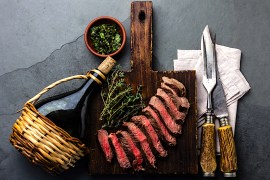How to Replicate the Frying Effect on Grid
I always say that, practically at every class: the main evolution of modern grilling devices compared to traditional brazier is the presence of the lid. This has added to classical irradiation effects, the refraction and convection actions, opening grilling to an almost infinite range of possible extensions and pairing the BBQ cooking to other more acclaimed cooking forms. Think about how much laughter our parents would have done if thirty years ago (eh, time passes by…), during the smoky and charred August grilling cookouts, somebody went to tell them that in a way not so different they could cook Risotto, Pizzas, cakes and so on. Today in the grill almost everything is possible, gaining a unique taste and consistency, illuminating barbecue cooking by its own light. Despite this, there are still borderline applications, which still results in some way as adaptations and not true customizations. The most emblematic of what I happened to see is about fried.
The knot lies in the dry and intense temperature characterizing the BBQ world. This is its added value, but however poorly compatible with the burning trend of foods rich in starch or sugars in general, such as breadcrumbs or worse, egg. Over the years, I’ve seen a lot of effort in this matter with different solutions. The most credited is to not use the egg as a binder for baking, but I have also seen spraying with melted butter breaded chops in indirect cooking at magmatic temperatures. The fact is, as I said above, that these are adaptations, palliatives.
So I wanted to make a share of what I think is the best solution to get excellent fried food on barbecue field without being forced to fill the Wok with oil and use it as a fryer (which, with coals few centimeters far, always makes me a fear…). My system is based on three joint elements:
- I have to bother you for a few minutes to weave the praises of an accessory among the most neglected of the barbecue panorama, which turns out to be decisive for our purposes: the ceramic plate. Commercially, it is often proposed just as a cast iron plate with the advantage of not sticking the food while cooking. In fact, it is much, much more than this and has its own performance, strongly distinctive from other materials. Compared to a cast iron plate, the ceramic returns a much more homogeneous, uniform and constant heat, less violent with no peaks, which is ideal for our purposes: just a veil of oil on the plate will be kept constant at the temperature we need to fry homogeneously the food surface. To have an idea of what I am talking about, try to touch with your finger for a fraction of a second a cast iron plate and a ceramic one at the maximum temperature: with a ceramic plate it is much harder to burn foods and in that sense it’s the absolute alternative to the soapstone, which also suffer greatly from thermal excursions (is there anyone who never broke a soapstone?)
- The other important key is the grilling device: the ideal is a very powerful device with a relatively small baking chamber, in which the refraction effect is quite important. The method is based on a closed lid cooking, combined with irradiation through the plate and intense refraction through the lid. In this sense the perfect device is the Q3200 but any gas trolley device will be fine.

- It is necessary to facilitate the gilding, using a breading that becomes crispy very easily. The best solution I have found is to put three foil pans in line and fill the first with salted and peppered breadcrumbs, the second with a 15% blend of Corn Starch in Flour and the last with a beaten egg in 300 ml of milk. Breading is done by passing the food first in the milk, then into the flour, then again in the milk and finally into the breadcrumbs until the coating is thick and dry.
For our testing on fried food on plate we will make two recipes of different “thickness” in the physical sense of the term to see how the method works with two different bodies: the classic American onion rings and the italian Mozzarella in Carrozza. In our case we use the largest ceramic plate model, between the two on the market and the amount of oil used is about three tablespoons of peanut oil, added after a full-power heating, lasting about 10 minutes.
As mentioned, as soon as the rings are placed in the cooking we close the lid and let the powerful refraction do its job. After a few minutes we open to check and see that besides being golden at the point of contact, the rings begin to color over. We flip them and in no time the cooking is done.
We repeat the same thing with the Mozzarella in Carrozza, helping us with a burger blade to flip at half cooking. It is quite intuitive as the effect of refraction is particularly important in this second preparation. Particular care should therefore be taken to maximize the presence of the lid during cooking.
In conclusion, this is a very effective system that gives dry and really crunchy fried. The node on which you have to focus on is as specified, the lid: you should train yourself to use it not only to play on the refraction effect but also to keep the oil temperature at the required temperature. Its partial limit, as it turns out, is about high thickness: for us to understand, of course it would be unthinkable to fry a whole turkey with this method but for most common preparations, from chicken wings, to squid rings, from chips to veal cutlets, Is really effective. And you, what fried food would you see well on it?














